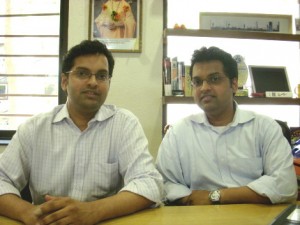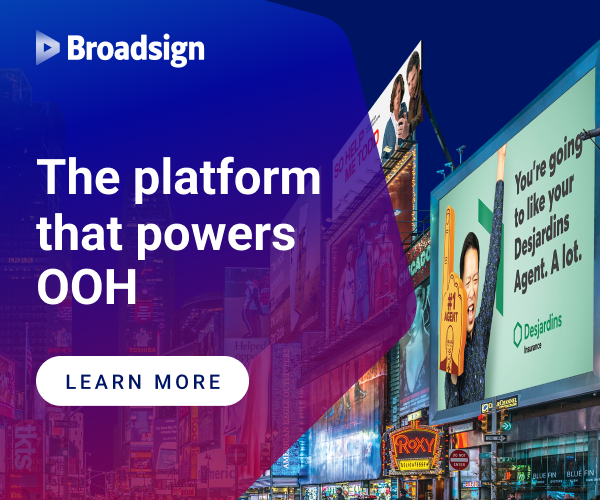Gail Chiasson, North American Editor
This month, in the CEO Spotlight, we welcome Gaurang Shah, President & CEO, Digital Signage Networks India, Mumbai
- You started your company with your twin brother at the young age of 24 in 2006. Where did you get the knowledge and experience to make such a leap of faith into the digital signage world?
After graduating from the University of Pennsylvania with dual degrees in Finance (from the Wharton Business School) and Electrical and Systems Engineering (from the Moore School), I worked at McKinsey and Company’s New York office for 2 years. Post McKinsey, I was in Mumbai for a summer vacation before I was scheduled to start work at a leading private equity firm in Boston.
It was during this vacation that I had the opportunity to witness the booming media and retail industries of India. After surveying over 50 malls and retail locations, the empirical evidence suggested that there was no solution in the market to communicate to consumers in a dynamic eye-catching way that was possible via a Digital Poster. This seemed like a good business opportunity to explore and so I started the company as a summer project. We negotiated with several mall owners and installed a few screens to test the business case.
When our first major break came with a pan-India tie-up for all the Café Coffee Day outlets, this summer project was about to balloon into a 22 city network. It was the perfect opportunity for me to realize my dream of working in India and running my own business to solve a unique problem instead of just replicating what was already being done. It was time to take the plunge away from a cushy corporate career.
- I notice that your university education was in the U.S. at the University of Pennsylvania’s Wharton School of Business. What made you decide to go there rather than a university in India or elsewhere in the U.S.?
After securing full scholarships to the Asheville School, one of the premier high schools in the U.S., Devang and I had a first hand exposure to the US educational system. We knew then that we wanted to pursue our higher education, also in the U.S.. We both had a strong interest in business, given our upbringing in an entrepreneurial family, as well as math and sciences. The University of Pennsylvania offered us the perfect solution where we could pursue both Business as well as Engineering degrees at the same time in the world’s no. 1 ranked school. As an Ivy League institution, the quality of the program and the experience was unparalleled where we were learning, not just from our classes, but from the students themselves.
- I see that you have investment capital from Sequoia Capital and Sam Balsara, chairman and managing director, Madison Communications. Was it difficult to get financial backing? What was your advantage? What advice would you give to other entrepreneurs looking for venture capital assistance?
Sequoia Capital has a history of backing young entrepreneurs with unique ideas. From Google, Yahoo!, to Cisco, it funds startups in the technology and media space. When we presented our ideas to Sequoia, it was very receptive as this was a new media concept and a very scalable model. Our company was at the nexus of the retail, media and technology boom of India and, with a large, growing population that spends more time out of home than in front of the TV, this concept is slated to take off. In addition, its management was appreciative of the education and professional background we had, as well our family history of setting up various businesses.
Besides the basic idea and our background, though, what really worked for us was that we had basic proof of a concept already in the market. We had a few contracts secured with the malls; a basic team in place; and we were about to start rolling out to the Café Coffee Day outlets pan-India. Our creative, technology and approach were unique compared to anyone else in that we were making the digital signs interactive posters that could be linked up to the Internet and mobile phones for creating campaigns with a much broader appeal to advertisers.
Sam Balsara made an investment and joined our Board of Directors around the same time as well. From his vantage point as one of the largest media agencies of the country, he has the opportunity to see across traditional and new media. Digital Out-of- Home, although a relatively new concept at the time, was something he could instantly appreciate as the ‘next big thing’ in media.
- What kind of information is carried on your screens? Is it all advertising? How long is a loop?
DSN has made a paradigm shift of providing advertisers the Interactive Digital Poster concept. Through various innovations, DSN has changed the landscape of the DOOH industry and made it an option that more and more advertisers are considering as seriously as traditional media like TV, Radio and Print. DSN has a dedicated creative team that makes content (videos, animations and pictures) specifically for the medium, instead of running TV commercials.
DSN has also networked all its screens to centralized servers to provide advertisers with solutions that were, until now, impossible in the OOH space in India – e.g. DSN dynamically changes content by linking the screens to advertisers’ websites. Using Bluetooth technology, consumers interact with the screens with their mobile phones through various applications.
DSN has also tied up with companies like ESPN, CNBC and Aaj Tak that provide sports, news and stock market updates to provide consumers with live content. In addition, DSN offers innovations like the Roadblock, where multiple creatives of a single advertiser are played on the screen without sharing the airtime with any other advertiser . DSN has also introduced the concept of Videowalls where the Digital Posters are combined with traditional static hoardings, giving advertisers the advantage of both dynamic advertisements and traditional static messages.
- I read that you have succeeded in targeting more than twice the number of eyeballs than your nearest competitor. What kind of measurement system do you use?
The DSN network is spread across the top 21 cities of India including Mumbai, Bangalore, Delhi, Kolkatta, Pune, Ahmedabad, Hyderabad, Chennai, Baroda, Indore, Nasik, Surat, Ludhiana, Amritsar, Jalander, Patiala, Panchkulla, Chandigarh, Lucknow, Kanpur, Kolhapur.
Over 1,500 LCD and LED panels that are installed in various public places focus on targeting high income, upper middle class and middle class audiences in the 15-40 age groups. DSN has built a network in one of the most sought after Youth & Young Adult Hangout Locations (Café Coffee Day, McDonald’s and colleges) and the Western and Central railway stations of Mumbai.
Like all networks, the metric for measuring eyeballs is footfalls in each location. Statistical data from our partners help us assess the number of footfalls in all these locations. For Café Coffee Day and McDonald’s, we get information on how many transactions have taken place on a monthly basis. For our railway networks, we know how many tickets are sold on a daily basis. A lot of this information is also publicly available.
- You have 1,500 screens in 22 cities Do you have plans to expand outside of India. If so, where and when?
Yes. We are always actively looking at all sorts of opportunities globally, since we have developed the expertise of setting up and running networks and costs that are far below the global benchmarks. Global networks would have to, of course, be in partnership with some local firms who can carry out the on-ground maintenance and sales functions. One market that looks very interesting at the moment is South Africa. We are also looking at content development and post-production work tie-ups where networks across the world leverage our creative prowess for their clients.
- What sizes are your screens? Who provides them?
The majority of our screens are 42” and 52”, with select screens being 32”. In certain railway installations. we have also installed 22” panels, as they are catered to one-on-one viewing by people purchasing tickets. All our screens are sourced locally through select distributors.
- You have clients mainly in retail outlets such as McDonald’s, Café Coffee Day and Starbucks, as well as in railway stations. Into what other fields, if any, do you hope to expand?
We are focusing on the Youth segment via our retail tie-ups with Café Coffee Day and McDonalds. In addition we are focused on masses through our railways station ticket counter networks across India. We hope to continue to expand our base in these two segments of youth and mass transit. Retail and airports are also options we will continually evaluate, albeit more cautiously, as the advertising market is yet to fully develop in these segments.
- You and your co-founder brother had similar education and backgrounds. How did you decide which of you would be CEO in the company? What is your strength?
Yes, both Devang and I have very similar backgrounds. However, I actually started the company in 2007 and Devang joined the company two years later. My prior experience has been more management/strategy related via McKinsey, and I’ve also had more operational experience by virtue of starting up from scratch. Devang’s focus has been on the sales effort of the company, as his prior experience on Wall Street has provided him excellent skills of sales and negotiations. However, we work in a very collaborative manner, so while I am the CEO, we both effectively run the company together like Co-CEOs.
- How strong is the DOOH industry in India? Does the government encourage the industry? Are there any drawbacks for its expansion?
From our position as one of the largest networks in the country, we believe the DOOH industry is reaching a mature stage very quickly. We have seen consistent strong revenue growth since our inception. Advertisers have started considering our networks as part of their core marketing plans, with over 80% of our revenues coming from repeat business.
With the high recall rates DSN is able to achieve through its innovations (the last survey revealed an 83% recall rate), it is making a huge impact in the way clients are able to communicate with their consumers. Via the significant value provided to partners, we are seeing a strong buy-in from them, as well – e.g. in Café Coffee Day and McDonald’s, we showcase relevant information for the patrons, such as special offers, menu items and interesting content. In the railways, screens are dual display units showcasing ticket information and important railway announcements for commuters.
Recently, we have been seeing various players of the DOOH industry asking us to help consolidate operations and aggregate networks across the country, due to our superior expertise in sales, technology, operations and creative. This has become a whole new business model for the company as it plays a pivotal role in shaping the industry and building scale across networks.
There is also a growing scope for installing private screen networks for various government and private enterprises. Instead of selling airtime to advertisers, network operators’ roles are changing to provide a communication link between the management and employees and customers.







February 26th, 2010 at 04:16 @220
[…] This week in the CEO Spotlight is Gaurang Shah, Digital Signage Networks India. Mumbai – see h… Posted by twitterfeed On February – 26 – 2010 […]
February 26th, 2010 at 21:52 @953
what software platform does DSN use?
June 17th, 2010 at 14:58 @665
We are a South African company and have recently identified DOOH as a growth market in South Africa. We are looking for business partners to assist us with developing this business opportunity in South Africa. Would your company be interested in exploring such an opportunity.